Talent Acquisition: Current Trends & Practices in Dubai Automotive
VerifiedAdded on 2023/06/10
|12
|3897
|469
Literature Review
AI Summary
This literature review investigates the role of talent acquisition within Dubai's automotive industry, examining current trends and practices. It highlights the challenges faced by the industry, including rediscovering talent, attracting experienced candidates, and adapting to specialized technology. The study emphasizes the importance of human resource development (HRD) in enhancing employee skills and aligning them with organizational culture. It addresses issues such as high employee turnover, the need for continuous training, and the impact of globalization on workplace diversity. The review also touches upon the UAE's automotive market dynamics, including its reliance on imports, economic growth factors, and the increasing demand for car accessories. The review uses literature to explore how companies can navigate these challenges to maintain a competitive edge in the evolving automotive landscape.
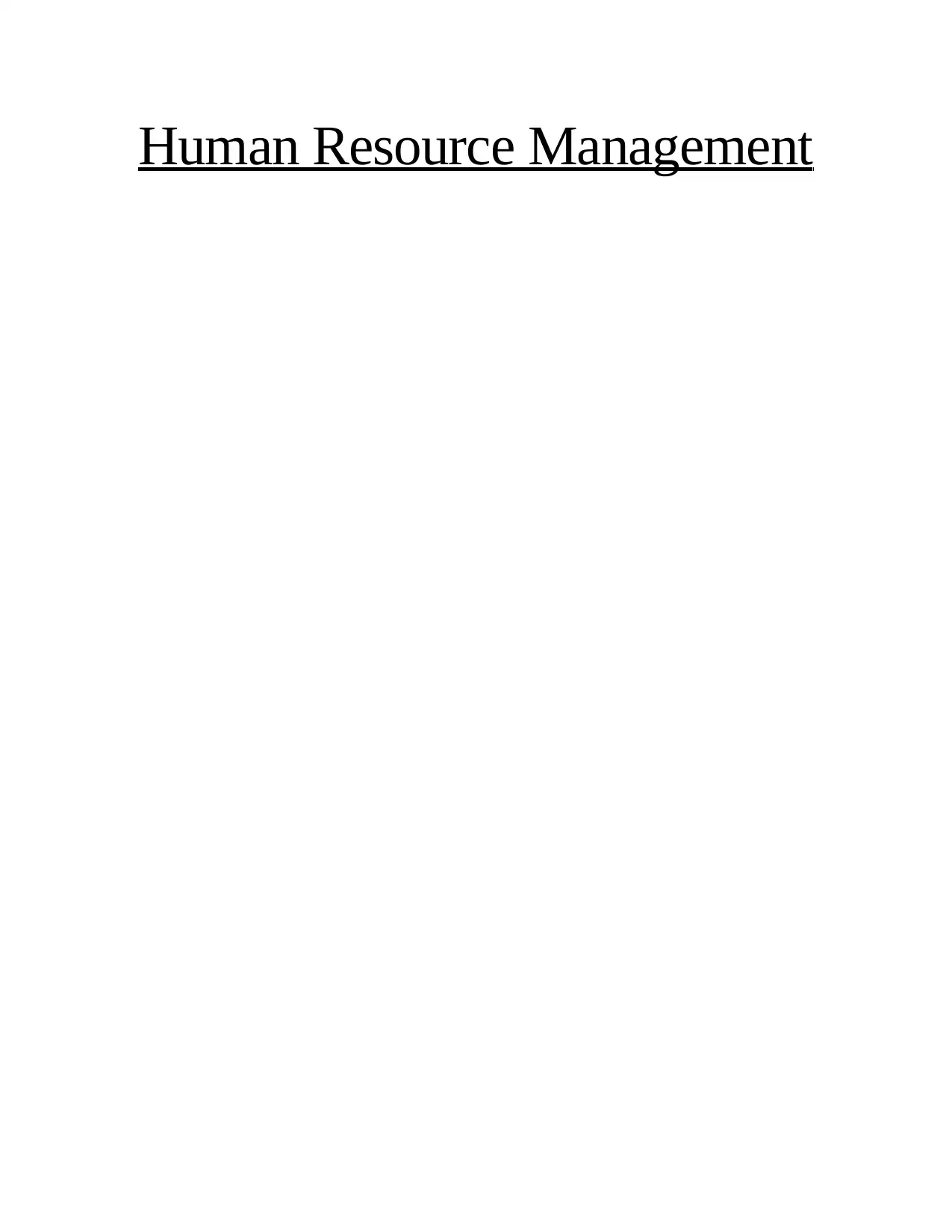
Human Resource Management
Paraphrase This Document
Need a fresh take? Get an instant paraphrase of this document with our AI Paraphraser
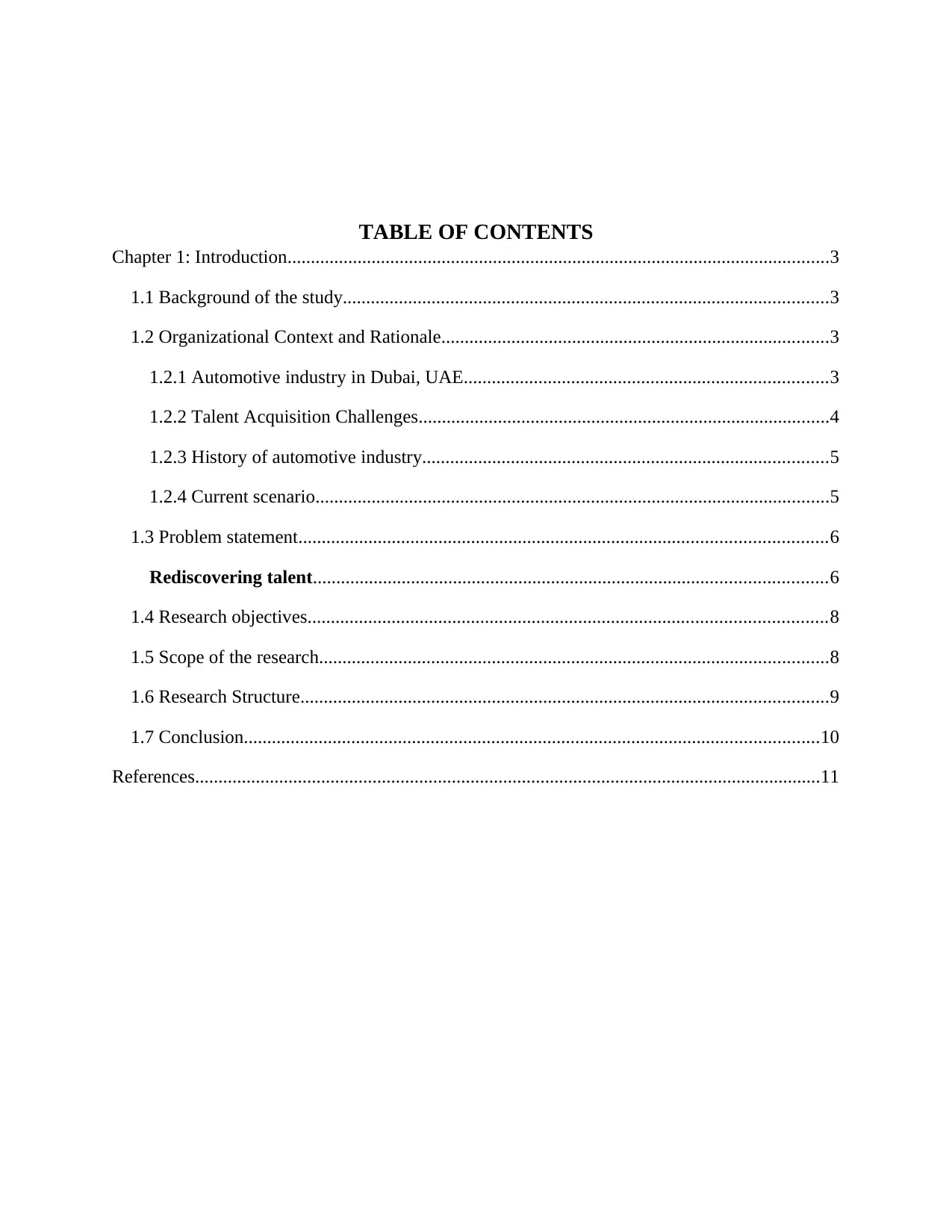
TABLE OF CONTENTS
Chapter 1: Introduction....................................................................................................................3
1.1 Background of the study........................................................................................................3
1.2 Organizational Context and Rationale...................................................................................3
1.2.1 Automotive industry in Dubai, UAE..............................................................................3
1.2.2 Talent Acquisition Challenges........................................................................................4
1.2.3 History of automotive industry.......................................................................................5
1.2.4 Current scenario..............................................................................................................5
1.3 Problem statement.................................................................................................................6
Rediscovering talent..............................................................................................................6
1.4 Research objectives...............................................................................................................8
1.5 Scope of the research.............................................................................................................8
1.6 Research Structure.................................................................................................................9
1.7 Conclusion...........................................................................................................................10
References......................................................................................................................................11
Chapter 1: Introduction....................................................................................................................3
1.1 Background of the study........................................................................................................3
1.2 Organizational Context and Rationale...................................................................................3
1.2.1 Automotive industry in Dubai, UAE..............................................................................3
1.2.2 Talent Acquisition Challenges........................................................................................4
1.2.3 History of automotive industry.......................................................................................5
1.2.4 Current scenario..............................................................................................................5
1.3 Problem statement.................................................................................................................6
Rediscovering talent..............................................................................................................6
1.4 Research objectives...............................................................................................................8
1.5 Scope of the research.............................................................................................................8
1.6 Research Structure.................................................................................................................9
1.7 Conclusion...........................................................................................................................10
References......................................................................................................................................11
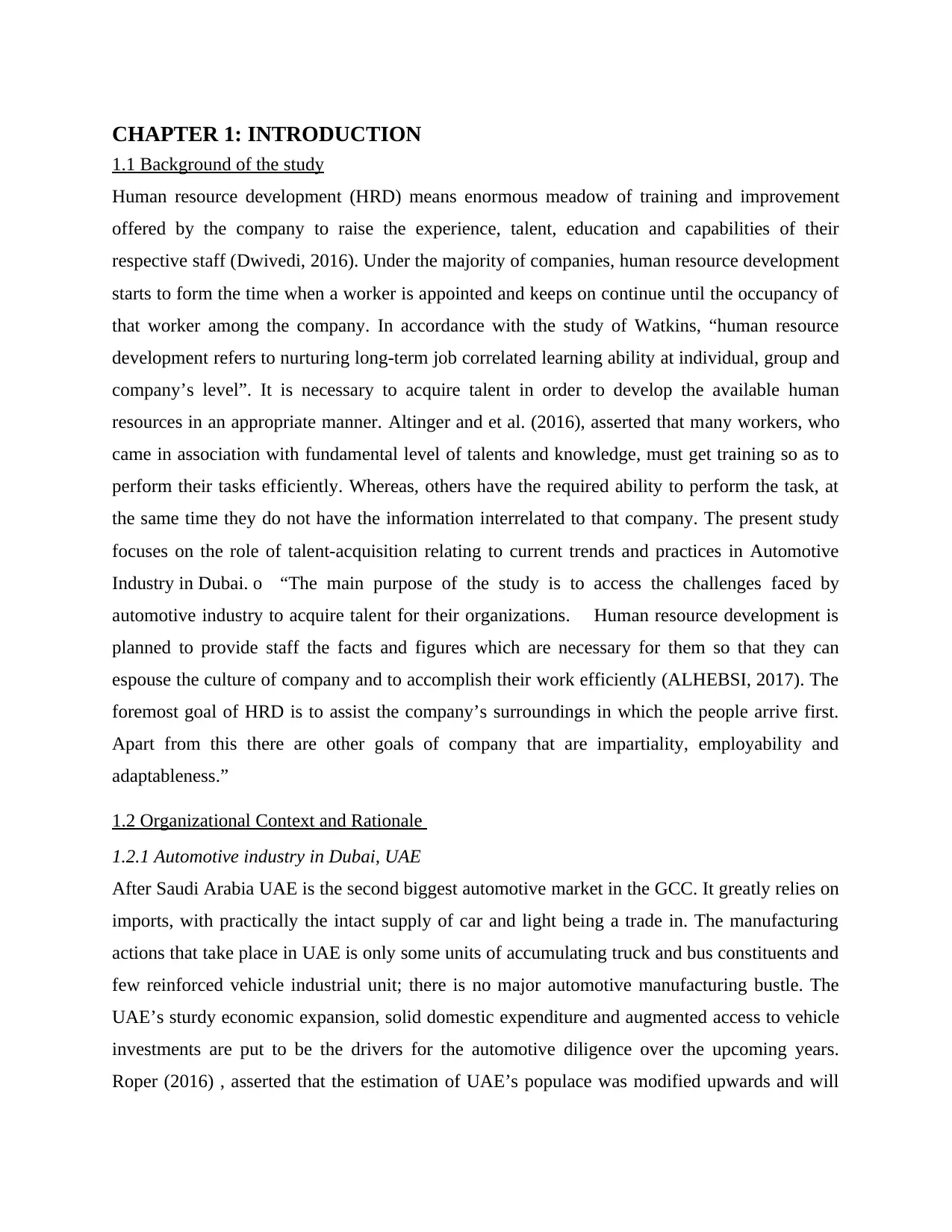
CHAPTER 1: INTRODUCTION
1.1 Background of the study
Human resource development (HRD) means enormous meadow of training and improvement
offered by the company to raise the experience, talent, education and capabilities of their
respective staff (Dwivedi, 2016). Under the majority of companies, human resource development
starts to form the time when a worker is appointed and keeps on continue until the occupancy of
that worker among the company. In accordance with the study of Watkins, “human resource
development refers to nurturing long-term job correlated learning ability at individual, group and
company’s level”. It is necessary to acquire talent in order to develop the available human
resources in an appropriate manner. Altinger and et al. (2016), asserted that many workers, who
came in association with fundamental level of talents and knowledge, must get training so as to
perform their tasks efficiently. Whereas, others have the required ability to perform the task, at
the same time they do not have the information interrelated to that company. The present study
focuses on the role of talent-acquisition relating to current trends and practices in Automotive
Industry in Dubai. o “The main purpose of the study is to access the challenges faced by
automotive industry to acquire talent for their organizations. Human resource development is
planned to provide staff the facts and figures which are necessary for them so that they can
espouse the culture of company and to accomplish their work efficiently (ALHEBSI, 2017). The
foremost goal of HRD is to assist the company’s surroundings in which the people arrive first.
Apart from this there are other goals of company that are impartiality, employability and
adaptableness.”
1.2 Organizational Context and Rationale
1.2.1 Automotive industry in Dubai, UAE
After Saudi Arabia UAE is the second biggest automotive market in the GCC. It greatly relies on
imports, with practically the intact supply of car and light being a trade in. The manufacturing
actions that take place in UAE is only some units of accumulating truck and bus constituents and
few reinforced vehicle industrial unit; there is no major automotive manufacturing bustle. The
UAE’s sturdy economic expansion, solid domestic expenditure and augmented access to vehicle
investments are put to be the drivers for the automotive diligence over the upcoming years.
Roper (2016) , asserted that the estimation of UAE’s populace was modified upwards and will
1.1 Background of the study
Human resource development (HRD) means enormous meadow of training and improvement
offered by the company to raise the experience, talent, education and capabilities of their
respective staff (Dwivedi, 2016). Under the majority of companies, human resource development
starts to form the time when a worker is appointed and keeps on continue until the occupancy of
that worker among the company. In accordance with the study of Watkins, “human resource
development refers to nurturing long-term job correlated learning ability at individual, group and
company’s level”. It is necessary to acquire talent in order to develop the available human
resources in an appropriate manner. Altinger and et al. (2016), asserted that many workers, who
came in association with fundamental level of talents and knowledge, must get training so as to
perform their tasks efficiently. Whereas, others have the required ability to perform the task, at
the same time they do not have the information interrelated to that company. The present study
focuses on the role of talent-acquisition relating to current trends and practices in Automotive
Industry in Dubai. o “The main purpose of the study is to access the challenges faced by
automotive industry to acquire talent for their organizations. Human resource development is
planned to provide staff the facts and figures which are necessary for them so that they can
espouse the culture of company and to accomplish their work efficiently (ALHEBSI, 2017). The
foremost goal of HRD is to assist the company’s surroundings in which the people arrive first.
Apart from this there are other goals of company that are impartiality, employability and
adaptableness.”
1.2 Organizational Context and Rationale
1.2.1 Automotive industry in Dubai, UAE
After Saudi Arabia UAE is the second biggest automotive market in the GCC. It greatly relies on
imports, with practically the intact supply of car and light being a trade in. The manufacturing
actions that take place in UAE is only some units of accumulating truck and bus constituents and
few reinforced vehicle industrial unit; there is no major automotive manufacturing bustle. The
UAE’s sturdy economic expansion, solid domestic expenditure and augmented access to vehicle
investments are put to be the drivers for the automotive diligence over the upcoming years.
Roper (2016) , asserted that the estimation of UAE’s populace was modified upwards and will
⊘ This is a preview!⊘
Do you want full access?
Subscribe today to unlock all pages.

Trusted by 1+ million students worldwide
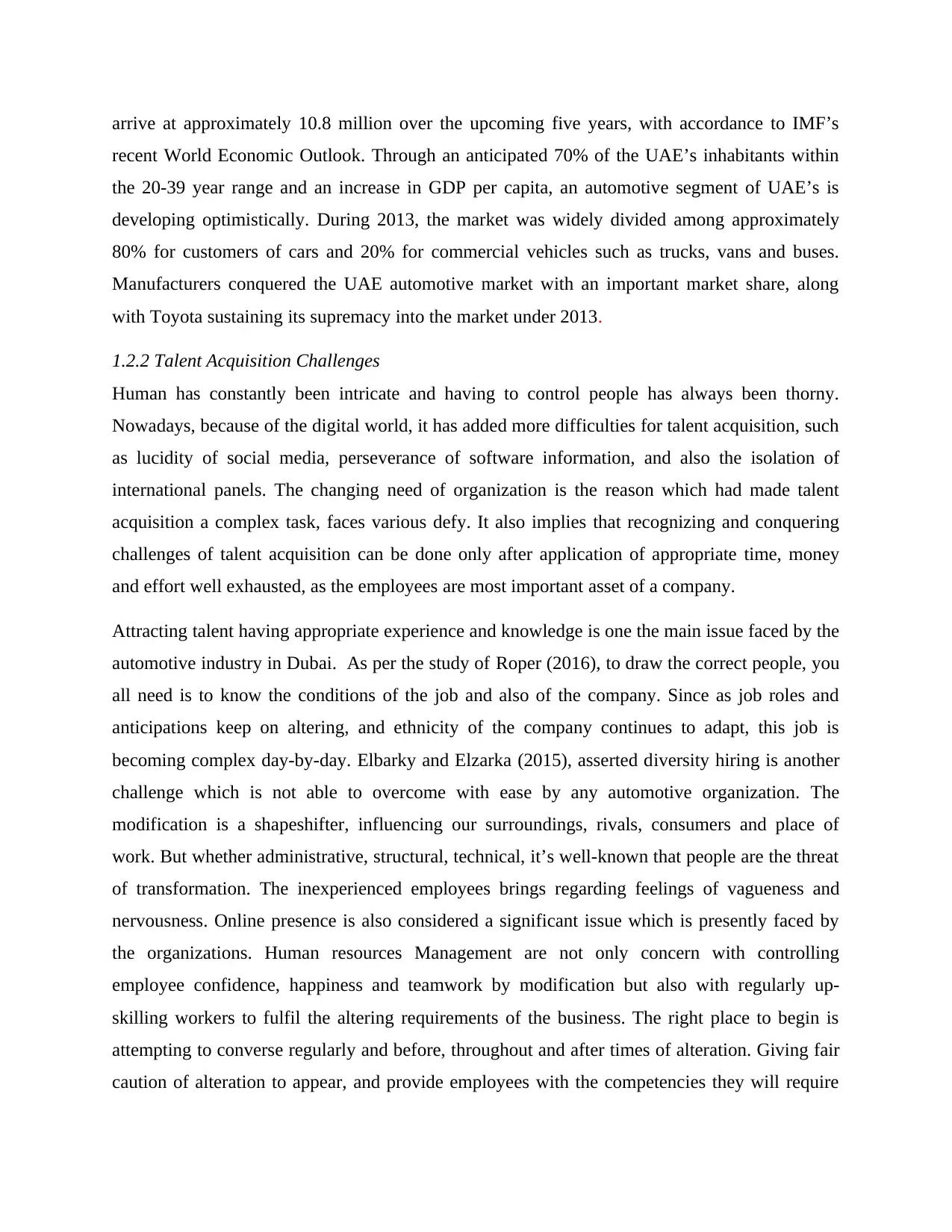
arrive at approximately 10.8 million over the upcoming five years, with accordance to IMF’s
recent World Economic Outlook. Through an anticipated 70% of the UAE’s inhabitants within
the 20-39 year range and an increase in GDP per capita, an automotive segment of UAE’s is
developing optimistically. During 2013, the market was widely divided among approximately
80% for customers of cars and 20% for commercial vehicles such as trucks, vans and buses.
Manufacturers conquered the UAE automotive market with an important market share, along
with Toyota sustaining its supremacy into the market under 2013.
1.2.2 Talent Acquisition Challenges
Human has constantly been intricate and having to control people has always been thorny.
Nowadays, because of the digital world, it has added more difficulties for talent acquisition, such
as lucidity of social media, perseverance of software information, and also the isolation of
international panels. The changing need of organization is the reason which had made talent
acquisition a complex task, faces various defy. It also implies that recognizing and conquering
challenges of talent acquisition can be done only after application of appropriate time, money
and effort well exhausted, as the employees are most important asset of a company.
Attracting talent having appropriate experience and knowledge is one the main issue faced by the
automotive industry in Dubai. As per the study of Roper (2016), to draw the correct people, you
all need is to know the conditions of the job and also of the company. Since as job roles and
anticipations keep on altering, and ethnicity of the company continues to adapt, this job is
becoming complex day-by-day. Elbarky and Elzarka (2015), asserted diversity hiring is another
challenge which is not able to overcome with ease by any automotive organization. The
modification is a shapeshifter, influencing our surroundings, rivals, consumers and place of
work. But whether administrative, structural, technical, it’s well-known that people are the threat
of transformation. The inexperienced employees brings regarding feelings of vagueness and
nervousness. Online presence is also considered a significant issue which is presently faced by
the organizations. Human resources Management are not only concern with controlling
employee confidence, happiness and teamwork by modification but also with regularly up-
skilling workers to fulfil the altering requirements of the business. The right place to begin is
attempting to converse regularly and before, throughout and after times of alteration. Giving fair
caution of alteration to appear, and provide employees with the competencies they will require
recent World Economic Outlook. Through an anticipated 70% of the UAE’s inhabitants within
the 20-39 year range and an increase in GDP per capita, an automotive segment of UAE’s is
developing optimistically. During 2013, the market was widely divided among approximately
80% for customers of cars and 20% for commercial vehicles such as trucks, vans and buses.
Manufacturers conquered the UAE automotive market with an important market share, along
with Toyota sustaining its supremacy into the market under 2013.
1.2.2 Talent Acquisition Challenges
Human has constantly been intricate and having to control people has always been thorny.
Nowadays, because of the digital world, it has added more difficulties for talent acquisition, such
as lucidity of social media, perseverance of software information, and also the isolation of
international panels. The changing need of organization is the reason which had made talent
acquisition a complex task, faces various defy. It also implies that recognizing and conquering
challenges of talent acquisition can be done only after application of appropriate time, money
and effort well exhausted, as the employees are most important asset of a company.
Attracting talent having appropriate experience and knowledge is one the main issue faced by the
automotive industry in Dubai. As per the study of Roper (2016), to draw the correct people, you
all need is to know the conditions of the job and also of the company. Since as job roles and
anticipations keep on altering, and ethnicity of the company continues to adapt, this job is
becoming complex day-by-day. Elbarky and Elzarka (2015), asserted diversity hiring is another
challenge which is not able to overcome with ease by any automotive organization. The
modification is a shapeshifter, influencing our surroundings, rivals, consumers and place of
work. But whether administrative, structural, technical, it’s well-known that people are the threat
of transformation. The inexperienced employees brings regarding feelings of vagueness and
nervousness. Online presence is also considered a significant issue which is presently faced by
the organizations. Human resources Management are not only concern with controlling
employee confidence, happiness and teamwork by modification but also with regularly up-
skilling workers to fulfil the altering requirements of the business. The right place to begin is
attempting to converse regularly and before, throughout and after times of alteration. Giving fair
caution of alteration to appear, and provide employees with the competencies they will require
Paraphrase This Document
Need a fresh take? Get an instant paraphrase of this document with our AI Paraphraser
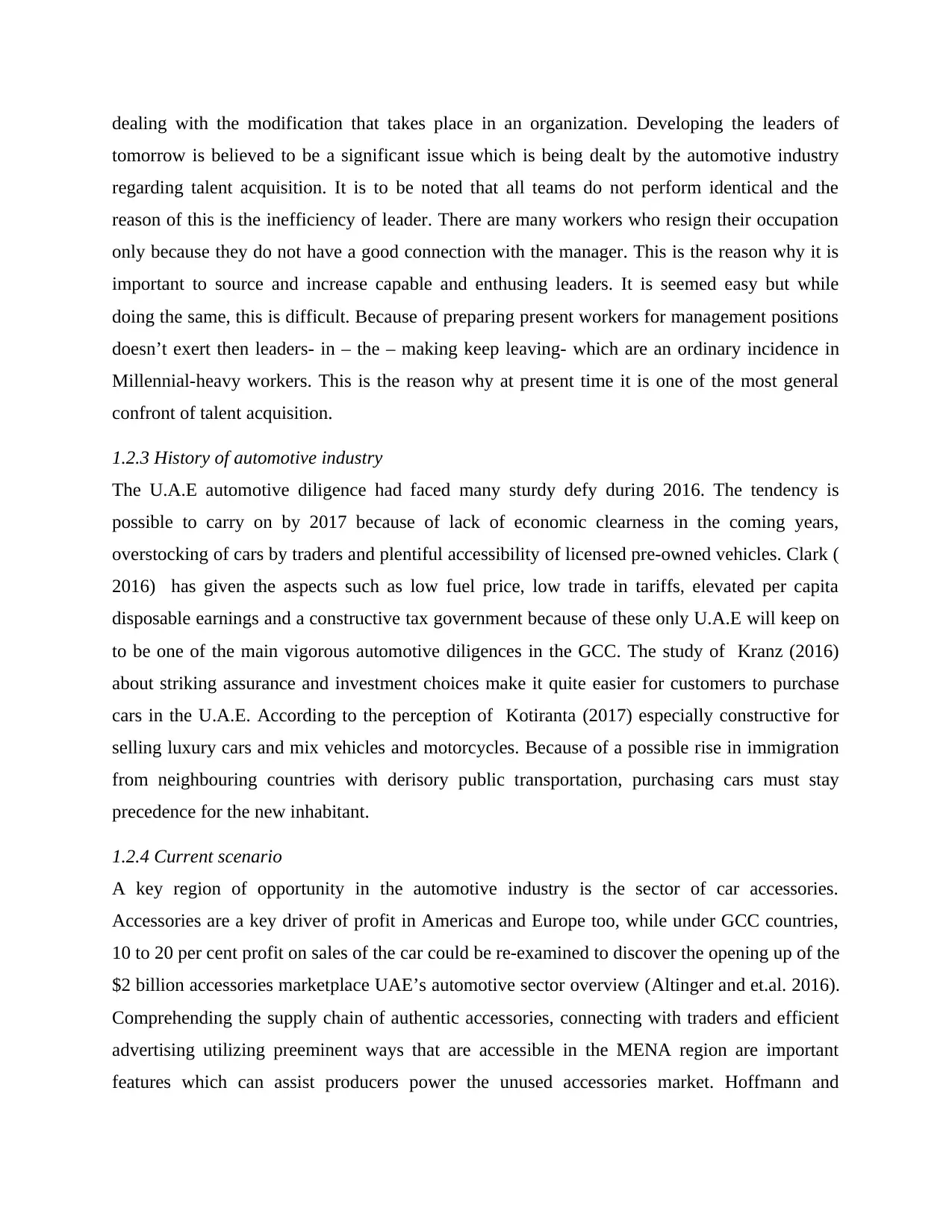
dealing with the modification that takes place in an organization. Developing the leaders of
tomorrow is believed to be a significant issue which is being dealt by the automotive industry
regarding talent acquisition. It is to be noted that all teams do not perform identical and the
reason of this is the inefficiency of leader. There are many workers who resign their occupation
only because they do not have a good connection with the manager. This is the reason why it is
important to source and increase capable and enthusing leaders. It is seemed easy but while
doing the same, this is difficult. Because of preparing present workers for management positions
doesn’t exert then leaders- in – the – making keep leaving- which are an ordinary incidence in
Millennial-heavy workers. This is the reason why at present time it is one of the most general
confront of talent acquisition.
1.2.3 History of automotive industry
The U.A.E automotive diligence had faced many sturdy defy during 2016. The tendency is
possible to carry on by 2017 because of lack of economic clearness in the coming years,
overstocking of cars by traders and plentiful accessibility of licensed pre-owned vehicles. Clark (
2016) has given the aspects such as low fuel price, low trade in tariffs, elevated per capita
disposable earnings and a constructive tax government because of these only U.A.E will keep on
to be one of the main vigorous automotive diligences in the GCC. The study of Kranz (2016)
about striking assurance and investment choices make it quite easier for customers to purchase
cars in the U.A.E. According to the perception of Kotiranta (2017) especially constructive for
selling luxury cars and mix vehicles and motorcycles. Because of a possible rise in immigration
from neighbouring countries with derisory public transportation, purchasing cars must stay
precedence for the new inhabitant.
1.2.4 Current scenario
A key region of opportunity in the automotive industry is the sector of car accessories.
Accessories are a key driver of profit in Americas and Europe too, while under GCC countries,
10 to 20 per cent profit on sales of the car could be re-examined to discover the opening up of the
$2 billion accessories marketplace UAE’s automotive sector overview (Altinger and et.al. 2016).
Comprehending the supply chain of authentic accessories, connecting with traders and efficient
advertising utilizing preeminent ways that are accessible in the MENA region are important
features which can assist producers power the unused accessories market. Hoffmann and
tomorrow is believed to be a significant issue which is being dealt by the automotive industry
regarding talent acquisition. It is to be noted that all teams do not perform identical and the
reason of this is the inefficiency of leader. There are many workers who resign their occupation
only because they do not have a good connection with the manager. This is the reason why it is
important to source and increase capable and enthusing leaders. It is seemed easy but while
doing the same, this is difficult. Because of preparing present workers for management positions
doesn’t exert then leaders- in – the – making keep leaving- which are an ordinary incidence in
Millennial-heavy workers. This is the reason why at present time it is one of the most general
confront of talent acquisition.
1.2.3 History of automotive industry
The U.A.E automotive diligence had faced many sturdy defy during 2016. The tendency is
possible to carry on by 2017 because of lack of economic clearness in the coming years,
overstocking of cars by traders and plentiful accessibility of licensed pre-owned vehicles. Clark (
2016) has given the aspects such as low fuel price, low trade in tariffs, elevated per capita
disposable earnings and a constructive tax government because of these only U.A.E will keep on
to be one of the main vigorous automotive diligences in the GCC. The study of Kranz (2016)
about striking assurance and investment choices make it quite easier for customers to purchase
cars in the U.A.E. According to the perception of Kotiranta (2017) especially constructive for
selling luxury cars and mix vehicles and motorcycles. Because of a possible rise in immigration
from neighbouring countries with derisory public transportation, purchasing cars must stay
precedence for the new inhabitant.
1.2.4 Current scenario
A key region of opportunity in the automotive industry is the sector of car accessories.
Accessories are a key driver of profit in Americas and Europe too, while under GCC countries,
10 to 20 per cent profit on sales of the car could be re-examined to discover the opening up of the
$2 billion accessories marketplace UAE’s automotive sector overview (Altinger and et.al. 2016).
Comprehending the supply chain of authentic accessories, connecting with traders and efficient
advertising utilizing preeminent ways that are accessible in the MENA region are important
features which can assist producers power the unused accessories market. Hoffmann and
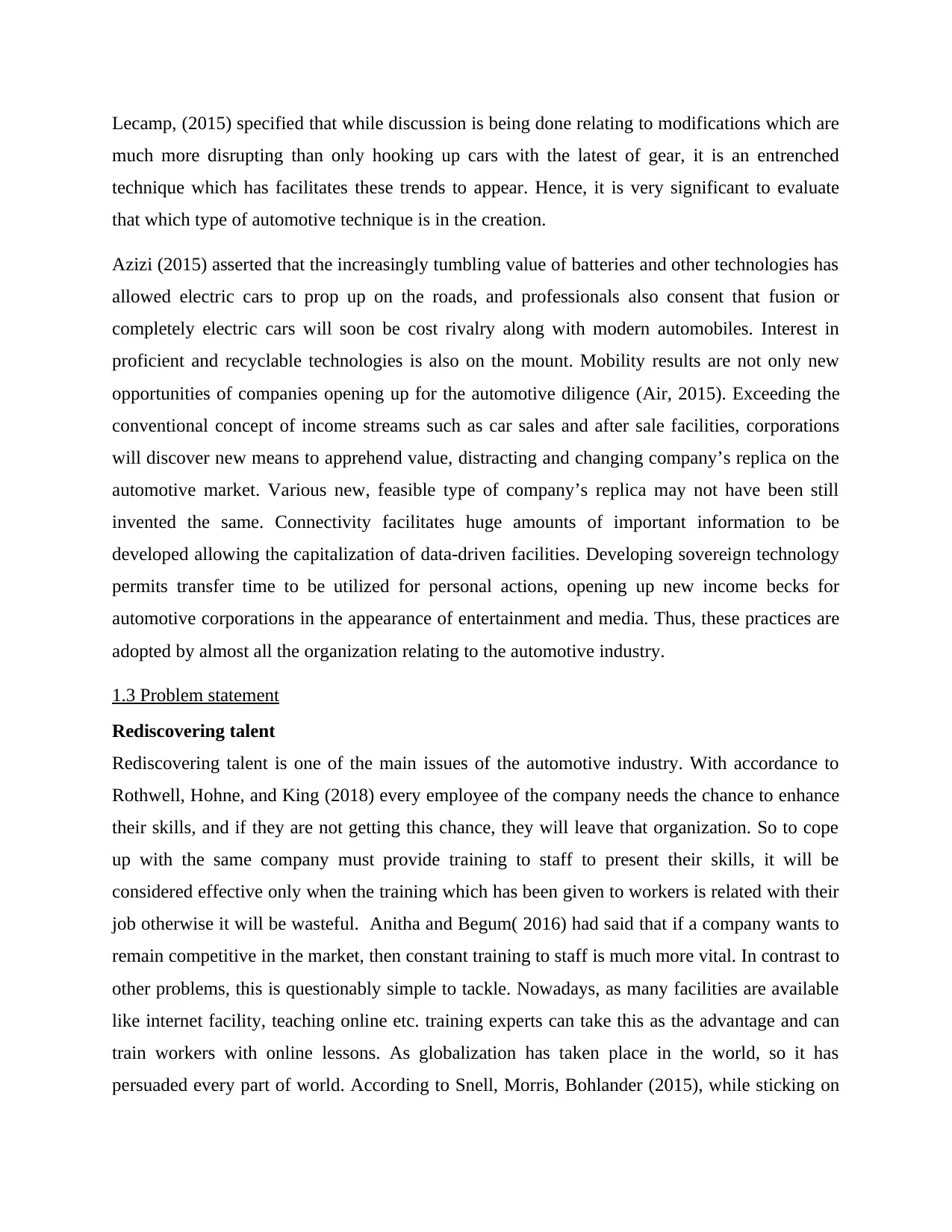
Lecamp, (2015) specified that while discussion is being done relating to modifications which are
much more disrupting than only hooking up cars with the latest of gear, it is an entrenched
technique which has facilitates these trends to appear. Hence, it is very significant to evaluate
that which type of automotive technique is in the creation.
Azizi (2015) asserted that the increasingly tumbling value of batteries and other technologies has
allowed electric cars to prop up on the roads, and professionals also consent that fusion or
completely electric cars will soon be cost rivalry along with modern automobiles. Interest in
proficient and recyclable technologies is also on the mount. Mobility results are not only new
opportunities of companies opening up for the automotive diligence (Air, 2015). Exceeding the
conventional concept of income streams such as car sales and after sale facilities, corporations
will discover new means to apprehend value, distracting and changing company’s replica on the
automotive market. Various new, feasible type of company’s replica may not have been still
invented the same. Connectivity facilitates huge amounts of important information to be
developed allowing the capitalization of data-driven facilities. Developing sovereign technology
permits transfer time to be utilized for personal actions, opening up new income becks for
automotive corporations in the appearance of entertainment and media. Thus, these practices are
adopted by almost all the organization relating to the automotive industry.
1.3 Problem statement
Rediscovering talent
Rediscovering talent is one of the main issues of the automotive industry. With accordance to
Rothwell, Hohne, and King (2018) every employee of the company needs the chance to enhance
their skills, and if they are not getting this chance, they will leave that organization. So to cope
up with the same company must provide training to staff to present their skills, it will be
considered effective only when the training which has been given to workers is related with their
job otherwise it will be wasteful. Anitha and Begum( 2016) had said that if a company wants to
remain competitive in the market, then constant training to staff is much more vital. In contrast to
other problems, this is questionably simple to tackle. Nowadays, as many facilities are available
like internet facility, teaching online etc. training experts can take this as the advantage and can
train workers with online lessons. As globalization has taken place in the world, so it has
persuaded every part of world. According to Snell, Morris, Bohlander (2015), while sticking on
much more disrupting than only hooking up cars with the latest of gear, it is an entrenched
technique which has facilitates these trends to appear. Hence, it is very significant to evaluate
that which type of automotive technique is in the creation.
Azizi (2015) asserted that the increasingly tumbling value of batteries and other technologies has
allowed electric cars to prop up on the roads, and professionals also consent that fusion or
completely electric cars will soon be cost rivalry along with modern automobiles. Interest in
proficient and recyclable technologies is also on the mount. Mobility results are not only new
opportunities of companies opening up for the automotive diligence (Air, 2015). Exceeding the
conventional concept of income streams such as car sales and after sale facilities, corporations
will discover new means to apprehend value, distracting and changing company’s replica on the
automotive market. Various new, feasible type of company’s replica may not have been still
invented the same. Connectivity facilitates huge amounts of important information to be
developed allowing the capitalization of data-driven facilities. Developing sovereign technology
permits transfer time to be utilized for personal actions, opening up new income becks for
automotive corporations in the appearance of entertainment and media. Thus, these practices are
adopted by almost all the organization relating to the automotive industry.
1.3 Problem statement
Rediscovering talent
Rediscovering talent is one of the main issues of the automotive industry. With accordance to
Rothwell, Hohne, and King (2018) every employee of the company needs the chance to enhance
their skills, and if they are not getting this chance, they will leave that organization. So to cope
up with the same company must provide training to staff to present their skills, it will be
considered effective only when the training which has been given to workers is related with their
job otherwise it will be wasteful. Anitha and Begum( 2016) had said that if a company wants to
remain competitive in the market, then constant training to staff is much more vital. In contrast to
other problems, this is questionably simple to tackle. Nowadays, as many facilities are available
like internet facility, teaching online etc. training experts can take this as the advantage and can
train workers with online lessons. As globalization has taken place in the world, so it has
persuaded every part of world. According to Snell, Morris, Bohlander (2015), while sticking on
⊘ This is a preview!⊘
Do you want full access?
Subscribe today to unlock all pages.

Trusted by 1+ million students worldwide
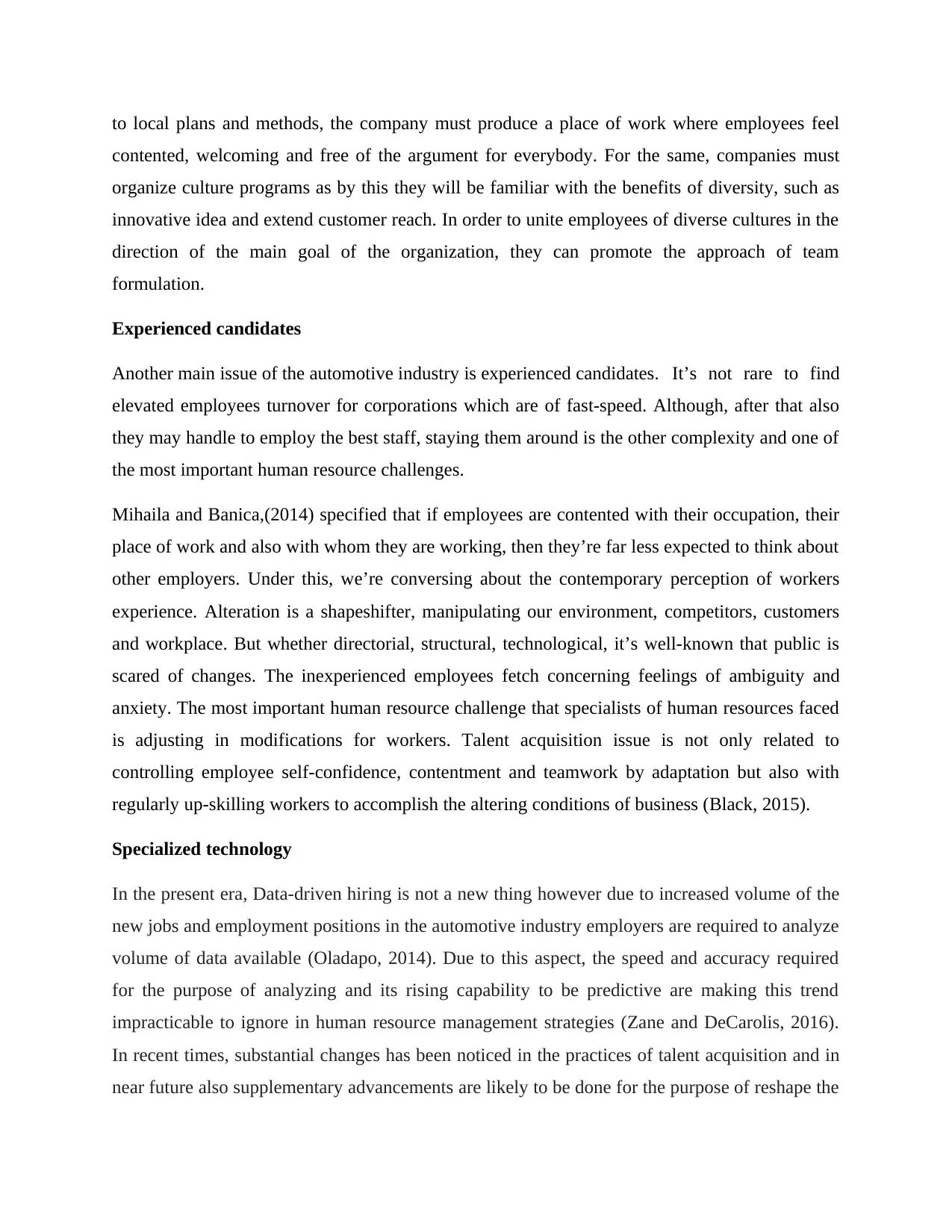
to local plans and methods, the company must produce a place of work where employees feel
contented, welcoming and free of the argument for everybody. For the same, companies must
organize culture programs as by this they will be familiar with the benefits of diversity, such as
innovative idea and extend customer reach. In order to unite employees of diverse cultures in the
direction of the main goal of the organization, they can promote the approach of team
formulation.
Experienced candidates
Another main issue of the automotive industry is experienced candidates. It’s not rare to find
elevated employees turnover for corporations which are of fast-speed. Although, after that also
they may handle to employ the best staff, staying them around is the other complexity and one of
the most important human resource challenges.
Mihaila and Banica,(2014) specified that if employees are contented with their occupation, their
place of work and also with whom they are working, then they’re far less expected to think about
other employers. Under this, we’re conversing about the contemporary perception of workers
experience. Alteration is a shapeshifter, manipulating our environment, competitors, customers
and workplace. But whether directorial, structural, technological, it’s well-known that public is
scared of changes. The inexperienced employees fetch concerning feelings of ambiguity and
anxiety. The most important human resource challenge that specialists of human resources faced
is adjusting in modifications for workers. Talent acquisition issue is not only related to
controlling employee self-confidence, contentment and teamwork by adaptation but also with
regularly up-skilling workers to accomplish the altering conditions of business (Black, 2015).
Specialized technology
In the present era, Data-driven hiring is not a new thing however due to increased volume of the
new jobs and employment positions in the automotive industry employers are required to analyze
volume of data available (Oladapo, 2014). Due to this aspect, the speed and accuracy required
for the purpose of analyzing and its rising capability to be predictive are making this trend
impracticable to ignore in human resource management strategies (Zane and DeCarolis, 2016).
In recent times, substantial changes has been noticed in the practices of talent acquisition and in
near future also supplementary advancements are likely to be done for the purpose of reshape the
contented, welcoming and free of the argument for everybody. For the same, companies must
organize culture programs as by this they will be familiar with the benefits of diversity, such as
innovative idea and extend customer reach. In order to unite employees of diverse cultures in the
direction of the main goal of the organization, they can promote the approach of team
formulation.
Experienced candidates
Another main issue of the automotive industry is experienced candidates. It’s not rare to find
elevated employees turnover for corporations which are of fast-speed. Although, after that also
they may handle to employ the best staff, staying them around is the other complexity and one of
the most important human resource challenges.
Mihaila and Banica,(2014) specified that if employees are contented with their occupation, their
place of work and also with whom they are working, then they’re far less expected to think about
other employers. Under this, we’re conversing about the contemporary perception of workers
experience. Alteration is a shapeshifter, manipulating our environment, competitors, customers
and workplace. But whether directorial, structural, technological, it’s well-known that public is
scared of changes. The inexperienced employees fetch concerning feelings of ambiguity and
anxiety. The most important human resource challenge that specialists of human resources faced
is adjusting in modifications for workers. Talent acquisition issue is not only related to
controlling employee self-confidence, contentment and teamwork by adaptation but also with
regularly up-skilling workers to accomplish the altering conditions of business (Black, 2015).
Specialized technology
In the present era, Data-driven hiring is not a new thing however due to increased volume of the
new jobs and employment positions in the automotive industry employers are required to analyze
volume of data available (Oladapo, 2014). Due to this aspect, the speed and accuracy required
for the purpose of analyzing and its rising capability to be predictive are making this trend
impracticable to ignore in human resource management strategies (Zane and DeCarolis, 2016).
In recent times, substantial changes has been noticed in the practices of talent acquisition and in
near future also supplementary advancements are likely to be done for the purpose of reshape the
Paraphrase This Document
Need a fresh take? Get an instant paraphrase of this document with our AI Paraphraser
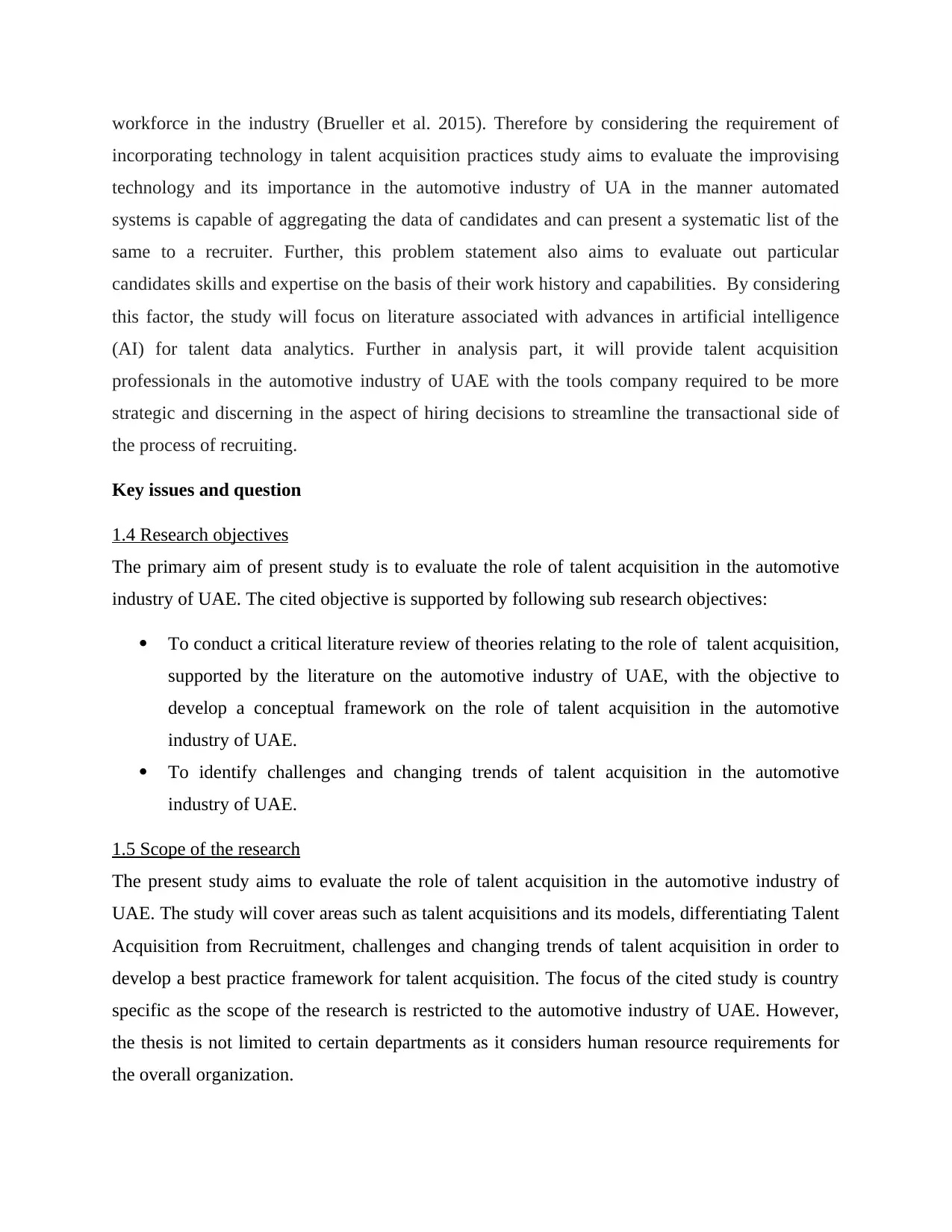
workforce in the industry (Brueller et al. 2015). Therefore by considering the requirement of
incorporating technology in talent acquisition practices study aims to evaluate the improvising
technology and its importance in the automotive industry of UA in the manner automated
systems is capable of aggregating the data of candidates and can present a systematic list of the
same to a recruiter. Further, this problem statement also aims to evaluate out particular
candidates skills and expertise on the basis of their work history and capabilities. By considering
this factor, the study will focus on literature associated with advances in artificial intelligence
(AI) for talent data analytics. Further in analysis part, it will provide talent acquisition
professionals in the automotive industry of UAE with the tools company required to be more
strategic and discerning in the aspect of hiring decisions to streamline the transactional side of
the process of recruiting.
Key issues and question
1.4 Research objectives
The primary aim of present study is to evaluate the role of talent acquisition in the automotive
industry of UAE. The cited objective is supported by following sub research objectives:
To conduct a critical literature review of theories relating to the role of talent acquisition,
supported by the literature on the automotive industry of UAE, with the objective to
develop a conceptual framework on the role of talent acquisition in the automotive
industry of UAE.
To identify challenges and changing trends of talent acquisition in the automotive
industry of UAE.
1.5 Scope of the research
The present study aims to evaluate the role of talent acquisition in the automotive industry of
UAE. The study will cover areas such as talent acquisitions and its models, differentiating Talent
Acquisition from Recruitment, challenges and changing trends of talent acquisition in order to
develop a best practice framework for talent acquisition. The focus of the cited study is country
specific as the scope of the research is restricted to the automotive industry of UAE. However,
the thesis is not limited to certain departments as it considers human resource requirements for
the overall organization.
incorporating technology in talent acquisition practices study aims to evaluate the improvising
technology and its importance in the automotive industry of UA in the manner automated
systems is capable of aggregating the data of candidates and can present a systematic list of the
same to a recruiter. Further, this problem statement also aims to evaluate out particular
candidates skills and expertise on the basis of their work history and capabilities. By considering
this factor, the study will focus on literature associated with advances in artificial intelligence
(AI) for talent data analytics. Further in analysis part, it will provide talent acquisition
professionals in the automotive industry of UAE with the tools company required to be more
strategic and discerning in the aspect of hiring decisions to streamline the transactional side of
the process of recruiting.
Key issues and question
1.4 Research objectives
The primary aim of present study is to evaluate the role of talent acquisition in the automotive
industry of UAE. The cited objective is supported by following sub research objectives:
To conduct a critical literature review of theories relating to the role of talent acquisition,
supported by the literature on the automotive industry of UAE, with the objective to
develop a conceptual framework on the role of talent acquisition in the automotive
industry of UAE.
To identify challenges and changing trends of talent acquisition in the automotive
industry of UAE.
1.5 Scope of the research
The present study aims to evaluate the role of talent acquisition in the automotive industry of
UAE. The study will cover areas such as talent acquisitions and its models, differentiating Talent
Acquisition from Recruitment, challenges and changing trends of talent acquisition in order to
develop a best practice framework for talent acquisition. The focus of the cited study is country
specific as the scope of the research is restricted to the automotive industry of UAE. However,
the thesis is not limited to certain departments as it considers human resource requirements for
the overall organization.
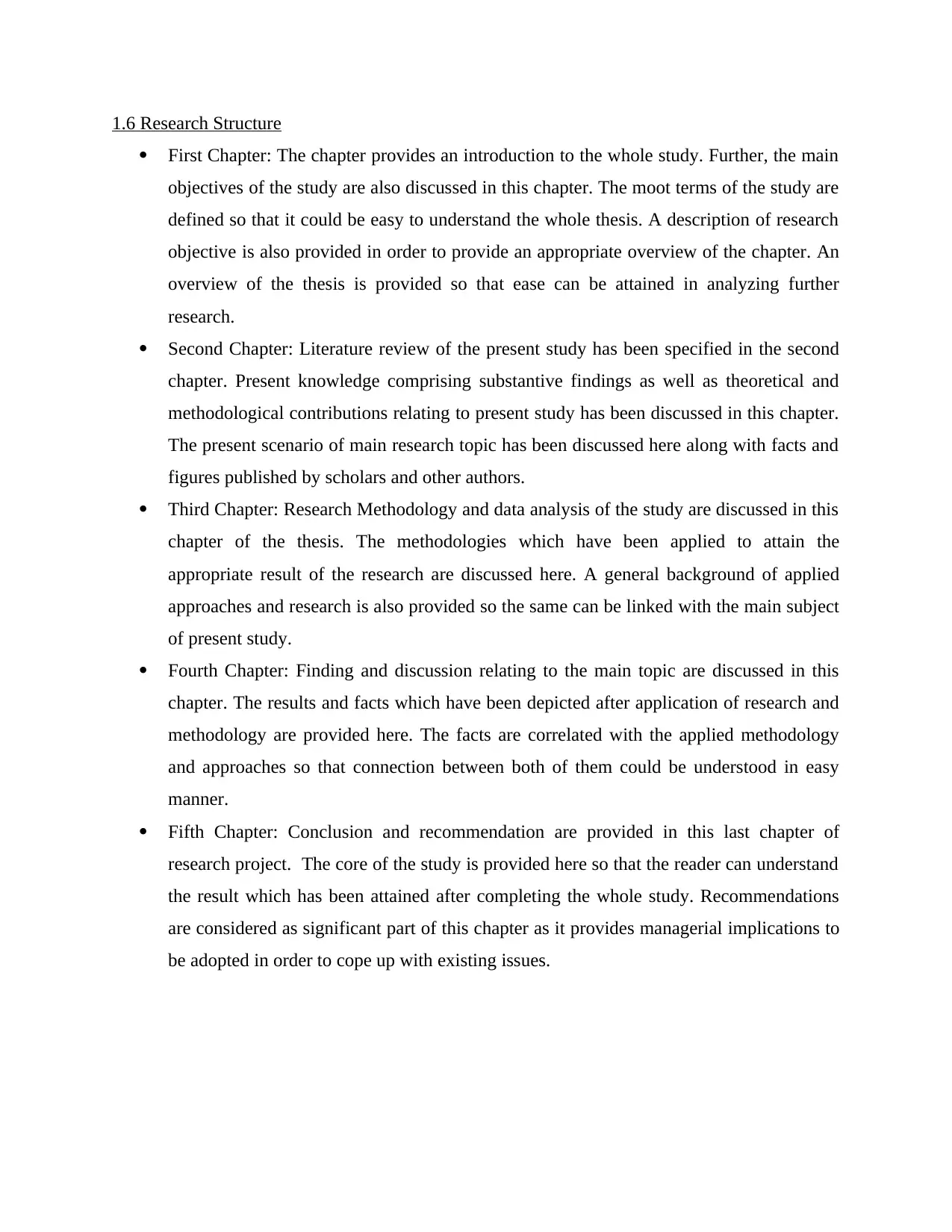
1.6 Research Structure
First Chapter: The chapter provides an introduction to the whole study. Further, the main
objectives of the study are also discussed in this chapter. The moot terms of the study are
defined so that it could be easy to understand the whole thesis. A description of research
objective is also provided in order to provide an appropriate overview of the chapter. An
overview of the thesis is provided so that ease can be attained in analyzing further
research.
Second Chapter: Literature review of the present study has been specified in the second
chapter. Present knowledge comprising substantive findings as well as theoretical and
methodological contributions relating to present study has been discussed in this chapter.
The present scenario of main research topic has been discussed here along with facts and
figures published by scholars and other authors.
Third Chapter: Research Methodology and data analysis of the study are discussed in this
chapter of the thesis. The methodologies which have been applied to attain the
appropriate result of the research are discussed here. A general background of applied
approaches and research is also provided so the same can be linked with the main subject
of present study.
Fourth Chapter: Finding and discussion relating to the main topic are discussed in this
chapter. The results and facts which have been depicted after application of research and
methodology are provided here. The facts are correlated with the applied methodology
and approaches so that connection between both of them could be understood in easy
manner.
Fifth Chapter: Conclusion and recommendation are provided in this last chapter of
research project. The core of the study is provided here so that the reader can understand
the result which has been attained after completing the whole study. Recommendations
are considered as significant part of this chapter as it provides managerial implications to
be adopted in order to cope up with existing issues.
First Chapter: The chapter provides an introduction to the whole study. Further, the main
objectives of the study are also discussed in this chapter. The moot terms of the study are
defined so that it could be easy to understand the whole thesis. A description of research
objective is also provided in order to provide an appropriate overview of the chapter. An
overview of the thesis is provided so that ease can be attained in analyzing further
research.
Second Chapter: Literature review of the present study has been specified in the second
chapter. Present knowledge comprising substantive findings as well as theoretical and
methodological contributions relating to present study has been discussed in this chapter.
The present scenario of main research topic has been discussed here along with facts and
figures published by scholars and other authors.
Third Chapter: Research Methodology and data analysis of the study are discussed in this
chapter of the thesis. The methodologies which have been applied to attain the
appropriate result of the research are discussed here. A general background of applied
approaches and research is also provided so the same can be linked with the main subject
of present study.
Fourth Chapter: Finding and discussion relating to the main topic are discussed in this
chapter. The results and facts which have been depicted after application of research and
methodology are provided here. The facts are correlated with the applied methodology
and approaches so that connection between both of them could be understood in easy
manner.
Fifth Chapter: Conclusion and recommendation are provided in this last chapter of
research project. The core of the study is provided here so that the reader can understand
the result which has been attained after completing the whole study. Recommendations
are considered as significant part of this chapter as it provides managerial implications to
be adopted in order to cope up with existing issues.
⊘ This is a preview!⊘
Do you want full access?
Subscribe today to unlock all pages.

Trusted by 1+ million students worldwide
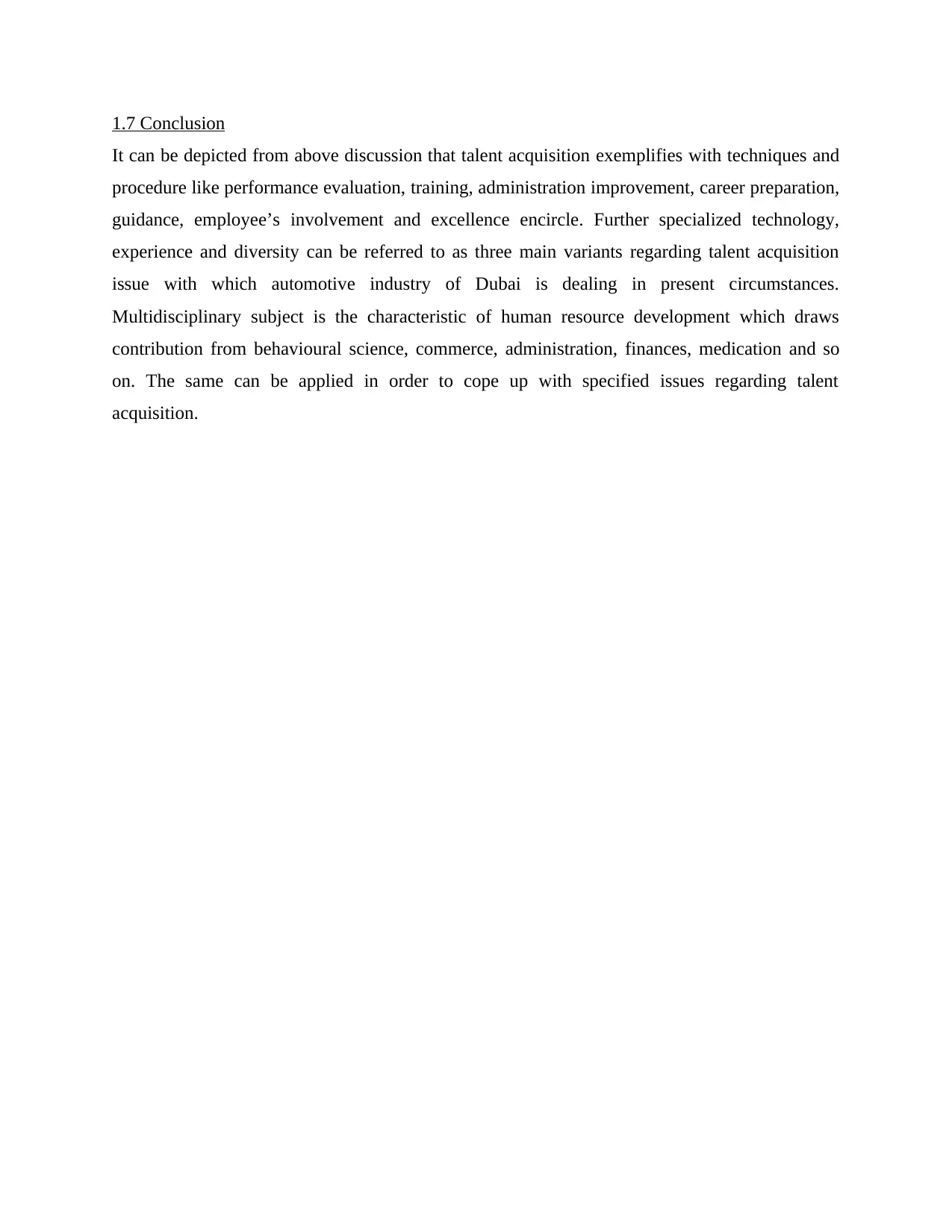
1.7 Conclusion
It can be depicted from above discussion that talent acquisition exemplifies with techniques and
procedure like performance evaluation, training, administration improvement, career preparation,
guidance, employee’s involvement and excellence encircle. Further specialized technology,
experience and diversity can be referred to as three main variants regarding talent acquisition
issue with which automotive industry of Dubai is dealing in present circumstances.
Multidisciplinary subject is the characteristic of human resource development which draws
contribution from behavioural science, commerce, administration, finances, medication and so
on. The same can be applied in order to cope up with specified issues regarding talent
acquisition.
It can be depicted from above discussion that talent acquisition exemplifies with techniques and
procedure like performance evaluation, training, administration improvement, career preparation,
guidance, employee’s involvement and excellence encircle. Further specialized technology,
experience and diversity can be referred to as three main variants regarding talent acquisition
issue with which automotive industry of Dubai is dealing in present circumstances.
Multidisciplinary subject is the characteristic of human resource development which draws
contribution from behavioural science, commerce, administration, finances, medication and so
on. The same can be applied in order to cope up with specified issues regarding talent
acquisition.
Paraphrase This Document
Need a fresh take? Get an instant paraphrase of this document with our AI Paraphraser
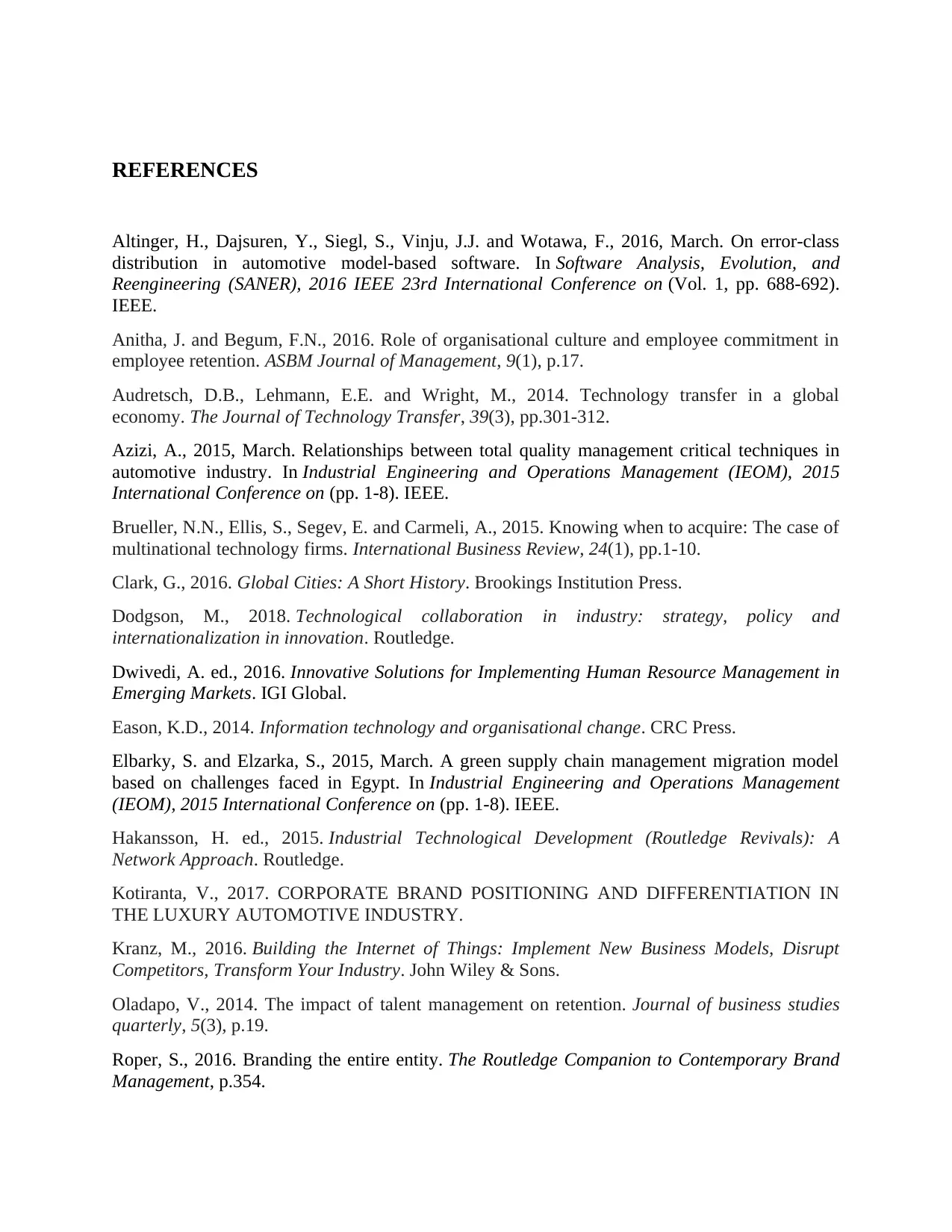
REFERENCES
Altinger, H., Dajsuren, Y., Siegl, S., Vinju, J.J. and Wotawa, F., 2016, March. On error-class
distribution in automotive model-based software. In Software Analysis, Evolution, and
Reengineering (SANER), 2016 IEEE 23rd International Conference on (Vol. 1, pp. 688-692).
IEEE.
Anitha, J. and Begum, F.N., 2016. Role of organisational culture and employee commitment in
employee retention. ASBM Journal of Management, 9(1), p.17.
Audretsch, D.B., Lehmann, E.E. and Wright, M., 2014. Technology transfer in a global
economy. The Journal of Technology Transfer, 39(3), pp.301-312.
Azizi, A., 2015, March. Relationships between total quality management critical techniques in
automotive industry. In Industrial Engineering and Operations Management (IEOM), 2015
International Conference on (pp. 1-8). IEEE.
Brueller, N.N., Ellis, S., Segev, E. and Carmeli, A., 2015. Knowing when to acquire: The case of
multinational technology firms. International Business Review, 24(1), pp.1-10.
Clark, G., 2016. Global Cities: A Short History. Brookings Institution Press.
Dodgson, M., 2018. Technological collaboration in industry: strategy, policy and
internationalization in innovation. Routledge.
Dwivedi, A. ed., 2016. Innovative Solutions for Implementing Human Resource Management in
Emerging Markets. IGI Global.
Eason, K.D., 2014. Information technology and organisational change. CRC Press.
Elbarky, S. and Elzarka, S., 2015, March. A green supply chain management migration model
based on challenges faced in Egypt. In Industrial Engineering and Operations Management
(IEOM), 2015 International Conference on (pp. 1-8). IEEE.
Hakansson, H. ed., 2015. Industrial Technological Development (Routledge Revivals): A
Network Approach. Routledge.
Kotiranta, V., 2017. CORPORATE BRAND POSITIONING AND DIFFERENTIATION IN
THE LUXURY AUTOMOTIVE INDUSTRY.
Kranz, M., 2016. Building the Internet of Things: Implement New Business Models, Disrupt
Competitors, Transform Your Industry. John Wiley & Sons.
Oladapo, V., 2014. The impact of talent management on retention. Journal of business studies
quarterly, 5(3), p.19.
Roper, S., 2016. Branding the entire entity. The Routledge Companion to Contemporary Brand
Management, p.354.
Altinger, H., Dajsuren, Y., Siegl, S., Vinju, J.J. and Wotawa, F., 2016, March. On error-class
distribution in automotive model-based software. In Software Analysis, Evolution, and
Reengineering (SANER), 2016 IEEE 23rd International Conference on (Vol. 1, pp. 688-692).
IEEE.
Anitha, J. and Begum, F.N., 2016. Role of organisational culture and employee commitment in
employee retention. ASBM Journal of Management, 9(1), p.17.
Audretsch, D.B., Lehmann, E.E. and Wright, M., 2014. Technology transfer in a global
economy. The Journal of Technology Transfer, 39(3), pp.301-312.
Azizi, A., 2015, March. Relationships between total quality management critical techniques in
automotive industry. In Industrial Engineering and Operations Management (IEOM), 2015
International Conference on (pp. 1-8). IEEE.
Brueller, N.N., Ellis, S., Segev, E. and Carmeli, A., 2015. Knowing when to acquire: The case of
multinational technology firms. International Business Review, 24(1), pp.1-10.
Clark, G., 2016. Global Cities: A Short History. Brookings Institution Press.
Dodgson, M., 2018. Technological collaboration in industry: strategy, policy and
internationalization in innovation. Routledge.
Dwivedi, A. ed., 2016. Innovative Solutions for Implementing Human Resource Management in
Emerging Markets. IGI Global.
Eason, K.D., 2014. Information technology and organisational change. CRC Press.
Elbarky, S. and Elzarka, S., 2015, March. A green supply chain management migration model
based on challenges faced in Egypt. In Industrial Engineering and Operations Management
(IEOM), 2015 International Conference on (pp. 1-8). IEEE.
Hakansson, H. ed., 2015. Industrial Technological Development (Routledge Revivals): A
Network Approach. Routledge.
Kotiranta, V., 2017. CORPORATE BRAND POSITIONING AND DIFFERENTIATION IN
THE LUXURY AUTOMOTIVE INDUSTRY.
Kranz, M., 2016. Building the Internet of Things: Implement New Business Models, Disrupt
Competitors, Transform Your Industry. John Wiley & Sons.
Oladapo, V., 2014. The impact of talent management on retention. Journal of business studies
quarterly, 5(3), p.19.
Roper, S., 2016. Branding the entire entity. The Routledge Companion to Contemporary Brand
Management, p.354.
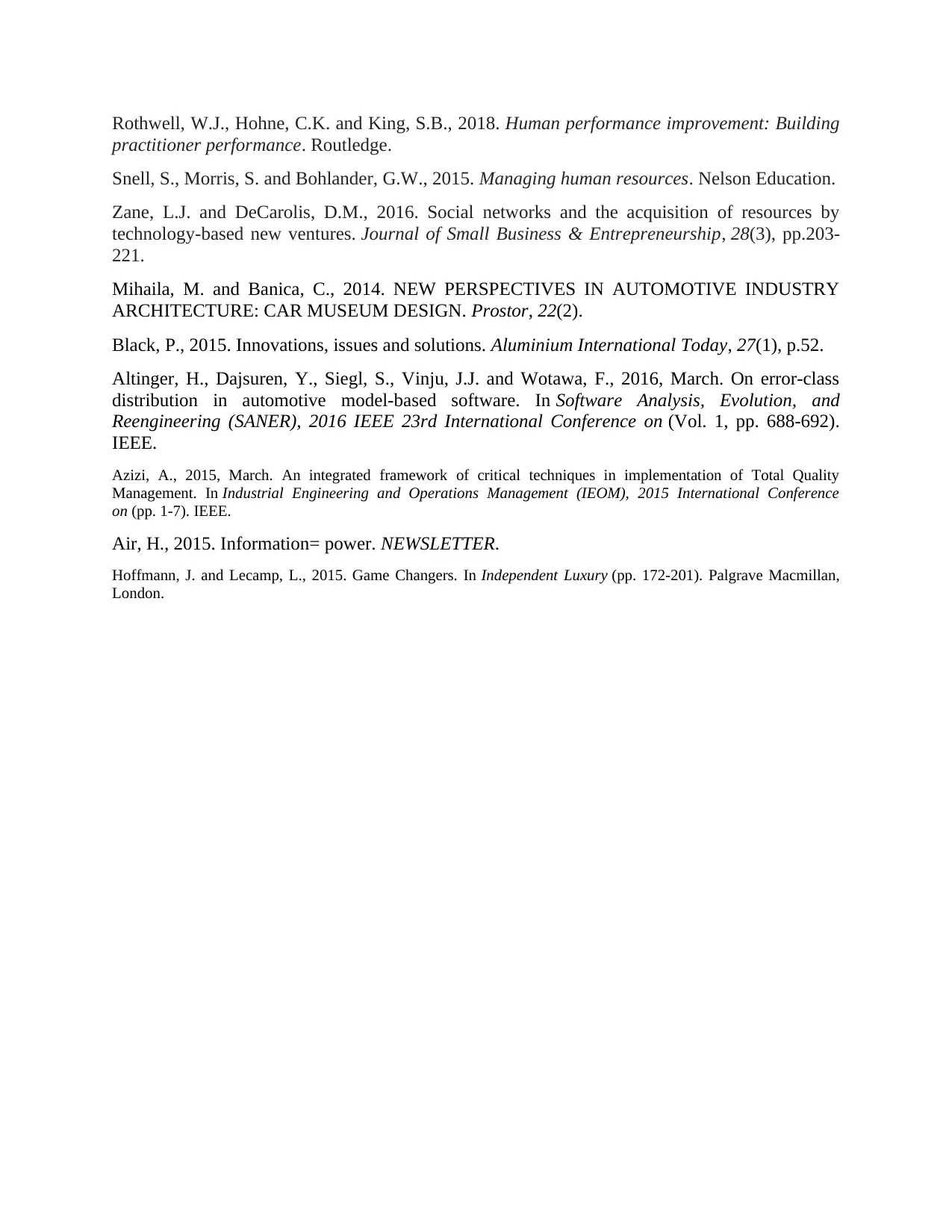
Rothwell, W.J., Hohne, C.K. and King, S.B., 2018. Human performance improvement: Building
practitioner performance. Routledge.
Snell, S., Morris, S. and Bohlander, G.W., 2015. Managing human resources. Nelson Education.
Zane, L.J. and DeCarolis, D.M., 2016. Social networks and the acquisition of resources by
technology-based new ventures. Journal of Small Business & Entrepreneurship, 28(3), pp.203-
221.
Mihaila, M. and Banica, C., 2014. NEW PERSPECTIVES IN AUTOMOTIVE INDUSTRY
ARCHITECTURE: CAR MUSEUM DESIGN. Prostor, 22(2).
Black, P., 2015. Innovations, issues and solutions. Aluminium International Today, 27(1), p.52.
Altinger, H., Dajsuren, Y., Siegl, S., Vinju, J.J. and Wotawa, F., 2016, March. On error-class
distribution in automotive model-based software. In Software Analysis, Evolution, and
Reengineering (SANER), 2016 IEEE 23rd International Conference on (Vol. 1, pp. 688-692).
IEEE.
Azizi, A., 2015, March. An integrated framework of critical techniques in implementation of Total Quality
Management. In Industrial Engineering and Operations Management (IEOM), 2015 International Conference
on (pp. 1-7). IEEE.
Air, H., 2015. Information= power. NEWSLETTER.
Hoffmann, J. and Lecamp, L., 2015. Game Changers. In Independent Luxury (pp. 172-201). Palgrave Macmillan,
London.
practitioner performance. Routledge.
Snell, S., Morris, S. and Bohlander, G.W., 2015. Managing human resources. Nelson Education.
Zane, L.J. and DeCarolis, D.M., 2016. Social networks and the acquisition of resources by
technology-based new ventures. Journal of Small Business & Entrepreneurship, 28(3), pp.203-
221.
Mihaila, M. and Banica, C., 2014. NEW PERSPECTIVES IN AUTOMOTIVE INDUSTRY
ARCHITECTURE: CAR MUSEUM DESIGN. Prostor, 22(2).
Black, P., 2015. Innovations, issues and solutions. Aluminium International Today, 27(1), p.52.
Altinger, H., Dajsuren, Y., Siegl, S., Vinju, J.J. and Wotawa, F., 2016, March. On error-class
distribution in automotive model-based software. In Software Analysis, Evolution, and
Reengineering (SANER), 2016 IEEE 23rd International Conference on (Vol. 1, pp. 688-692).
IEEE.
Azizi, A., 2015, March. An integrated framework of critical techniques in implementation of Total Quality
Management. In Industrial Engineering and Operations Management (IEOM), 2015 International Conference
on (pp. 1-7). IEEE.
Air, H., 2015. Information= power. NEWSLETTER.
Hoffmann, J. and Lecamp, L., 2015. Game Changers. In Independent Luxury (pp. 172-201). Palgrave Macmillan,
London.
⊘ This is a preview!⊘
Do you want full access?
Subscribe today to unlock all pages.

Trusted by 1+ million students worldwide
1 out of 12
Related Documents
Your All-in-One AI-Powered Toolkit for Academic Success.
+13062052269
info@desklib.com
Available 24*7 on WhatsApp / Email
![[object Object]](/_next/static/media/star-bottom.7253800d.svg)
Unlock your academic potential
Copyright © 2020–2025 A2Z Services. All Rights Reserved. Developed and managed by ZUCOL.




